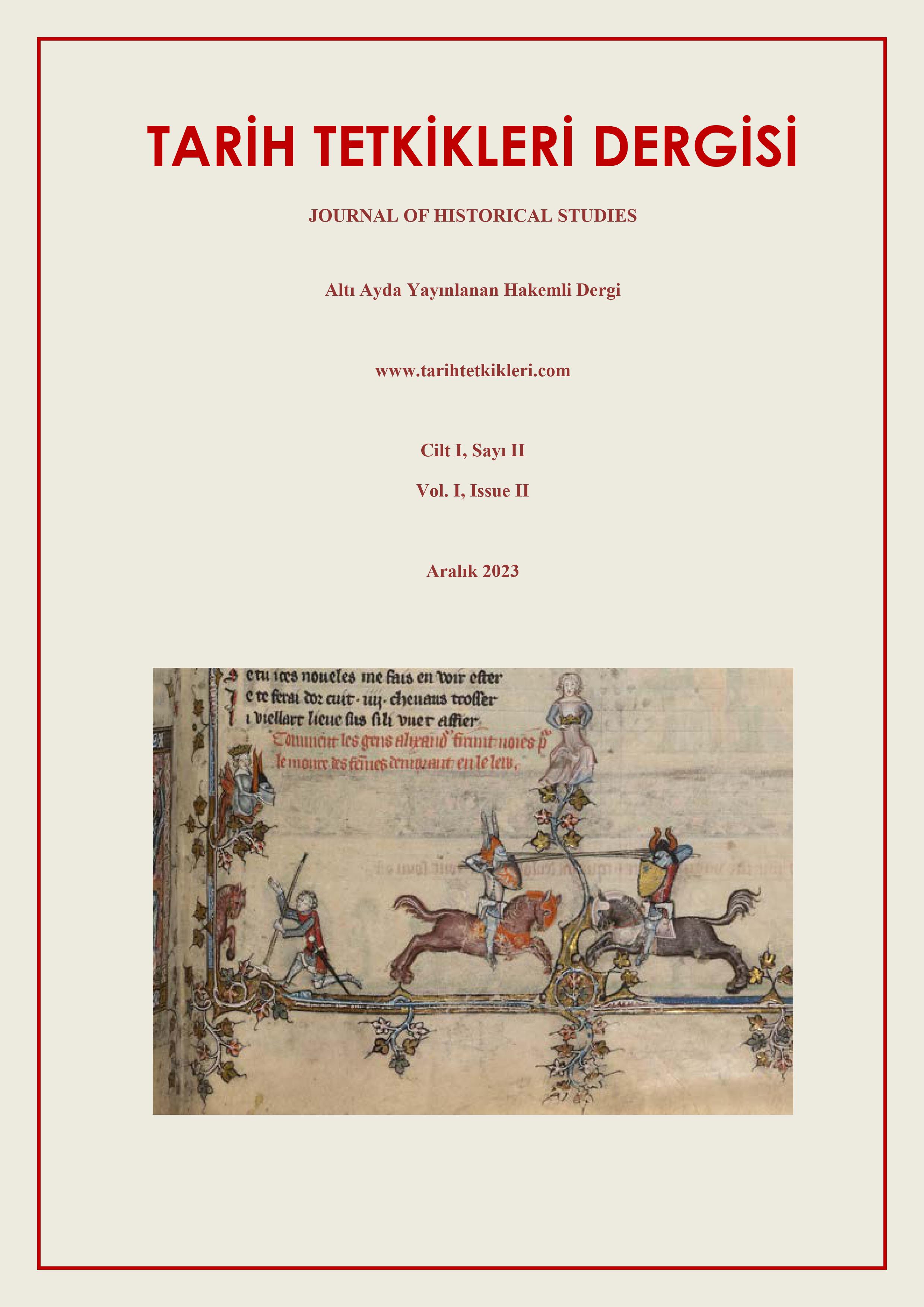The Europe as a Model. Regulation and modernization of the Ottoman fashion in the XIX century
DOI:
https://doi.org/10.5281/zenodo.10429115Anahtar Kelimeler:
Osmanlı Devleti, XIX. yüzyıl, III. Selim, II. Maḥmūd, moda, fesÖzet
XIX. yüzyıl Osmanlı İmparatorluğu’nda modernleşme devletin bekası için gerekli görülen ve çok çeşitli meseleleri kapsayan bir konuydu. Osmanlı padişahları Batı’nın siyasi olarak güçlenmesinin ardındaki sebepleri irdeleyip gelişmelere ayak uydururken modernleşme olarak sınıflandırılan adımları da kabul ettiler. Modernleşme konusunda Osmanlı toplumunda ve devlet yönetiminde pek çok mesele hem o günlerde hem de tarihçilerin araştırma konuları içerisinde tartışıldı. Batı ile etkileşim neredeyse kurulduğu günden beri devamlı süren Osmanlı Devletinde modernitenin bir parçasını da moda yani güncel kılık kıyafetlerin Batı’dan Osmanlı Devleti’ne girişi oluşturuyordu. Kadın-erkek giyiminde toplumda oluşan eğilimlerin Avrupa’dakine benzer bir sanayi devrimi yaşayarak Burjuvazinin ortaya çıkmadığı Osmanlı toplumunda nasıl bir değişim ve gelişime sahne olduğu bu çalışmanın konusunu oluşturmaktadır. Bu kapsamda çalışmanın kaynaklarını arşiv belgeleri ve telif-tetkik eserler oluşturmaktadır.
Referanslar
• C. Aktaş, Tanzimat’tan Günümüze Kılık Kıyafet ve Iktidar, Nehir Yayınları: İnceleme - Araştırma Dizisi, Istanbul, Nehir yayınları, 1989.
• P. L. Baker,The Fez in Turkey: A Symbol of Modernization, Costume, in “The Journal of the Costume Society”, 20, 1986, pp. 72-85.
• R. W. Bulliet, La civiltà islamico Cristiana. Una proposta, Laterza, Roma-Bari, 2005.
• J. P. Dunn, Clothes to Kill For: Uniforms and Politics in Ottoman Armies, in “The Journal of the Middle East and Africa”, 2, 1, 2011, pp.85-107.
• H. Exertzoglou,The cultural uses of consumption: negotiating class, gender, and nation in the Ottoman urban centers during the 19th century, in “International Journal of Middle East Studies”, 35, 1, 2003, pp. 77-101.
• A. Hatzimichali, The Greek Folk Costume, vol. II, Athens, Benaki Museum Publications, 1984.
• Ş. Hanioğlu,A Brief History of the Late Ottoman Empire, Princeton, Princeton University Press, 2008.
• U. Heyd,The Ottoman ‘Ulema and Westernization in the Time of Selım III and Mahmud II, en A. H. Hourani, P. S. Khoury, M. C. Wilson (eds.), The modern Middle East: a reader, Berkley, University of California Press, 1993.
• A. Jackson, A. Jaffer (eds.),Encounters. The Meeting of Asia and Europe, 1500-1800, London, V&A Publications, 2004.
• F. Koç, E. Koca,The Clothing Culture of the Turks, and the Entari (Part 1: History), in “Folk Life: Journal of Ethnological Studies”, 49/1, 2011, p. 22.
• R. E. Koçu,Türk Giyim, Kuşam ve Süslenme Sözlüğü, Sümerbank Kültür Yayınları 1, Ankara, Başnur Matbaası, 1967.
• M. Lale,“Sultan Mahmud II and the Fez Revolution”, in K. Çiçek (ed.), The Great Ottoman-Turkish Civilization, Philosophy, Science and Institutions, Ankara, Yeni Türkiye, 2000.
• B. Lewis,The emergence of modern Turkey, Oxford University Press, Oxford, 2000.
• A. Lütfi,“Vakanüvis Ahmed Lütfi Efendi Tarihi”, in A. Hezarfen, N. Akbayar (eds.), Tarih Vakfı-Yapı Kredi Yayınları: Eski Yazıdan Yeni Yazıya,vol. 2/3,Istanbul, Tarih Vakfı-Yapı Kredi yayınları, 1999.
• N. Micklewright,Women’s Dress in 19th century Istanbul: Mirror of a Changing Society, Tesis doctoral, Philadelphia, University of Pennsylvania, 1986.
• D. Quataert,Clothing Laws, State, and Society in the Ottoman Empire, 1720-1829, in “International Journal of Middle East Studies”, 29/3, 1997, pp. 403-425.
• Id., The Ottoman Empire, 1700-1922, Cambridge, Cambridge University Press, 2005.
• J. F. Richads,The Mughal Empire, Cambridge, Cambridge University Press, 1996.
• R. Ross,Clothing: A Global History, Cambridge, Polity, 2008.
• J. Scarce, Women’s Costume of the Near and Middle East, London, St Edmundsbury Pres Ltd, 2003.
• N. Sevin, Onüç Asırlık Türk Kiyâfet Târihine Bir Bakış, vol. 1, Ankara, Kültür Bakanlığı yayınları, 1991.
• S. J. Shaw, The origins of Ottoman military reform: the Nizam-i Cedid army of Sultan Selim III, in “The Journal of Modern History”, 37, 3, 1965.
• S. J. Shaw, E. K. Shaw,History of the Ottoman Empire and Modern Turkey, vol. II: Reform, Revolution, and Republic: The Rise of Modern Turkey, 1808-1975, Cambridge, Cambridge University Press, 1977.
• D. N. Stephanov,“Ruler Visibility, Modernity, and Ethnonationalism in the Late Ottoman Empire”, in Christine Isom-Verhaaren, K. F. Schull, Living in the Ottoman Realm: Empire and Identity, 13th to 20th Centuries, Bloomington, Indiana University Press, 2016.
• M. Tutar,Between Traditional and Modern: Men Dress Code in the Light of Turkish Modernization, Diplomski rad, Kraków, Jagiellonian University, 2014.
• M. C. Zilfi,“Whose Laws? Gendering the Ottoman Sumptuary Regime”, in S. Faroqhi, C. K. Neumann (eds.), Ottoman Costumes: From Textile to Identity, Istanbul, Eren, 2004.
İndir
Yayınlanmış
Nasıl Atıf Yapılır
Sayı
Bölüm
Lisans
Telif Hakkı (c) 2023 Eros Calcara

Bu çalışma Creative Commons Attribution 4.0 International License ile lisanslanmıştır.



